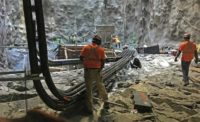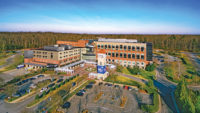After the parking structure was finished in March 2014, work began in earnest on the 21-story residential tower. The reinforced-concrete structure will house 450 apartments and eight levels of above-ground parking. The building, which topped out in November, will be clad in metal panels, curtain wall, punch windows and precast concrete.
Throughout the tower's construction, the team has monitored the structural system's performance twice a week. Now that the building has topped out and "pretty much settled," Fernandez says the system proved itself. "The maximum deflection we were expecting was ¾ inch," he says. "The maximum we've seen is 5/8 inch. We've proven it works."
Although plans for a future hotel on the site are still pending, the team has built its first level, providing structure to support a 200-room full-service hotel.
In the project's first phase, maintaining schedule was a primary focus. The facility was aiming to be completed in time for the opening of the adjacent Metro station, which was being built by Bechtel-led Dulles Transit Partners.
Ultimately, the opening of the Metro portion of the project was delayed by nearly six months, and Mesich says the Reston Station team used the added time to its advantage. "Once the Metro opened, we would have to work around active vehicular and pedestrian traffic," he says. "We had a plan, but those extra months allowed us time to practice and work with the county to tweak the plan as necessary."
Davis Construction also used the project as a pilot application of lean-construction techniques and tools, including the Last Planner system. Although it took some buy-in from subcontractors that had not used the system before, Mesich says the benefits became clear to everyone. "You get better quality, we've stayed on schedule and there's no cost to the owner," he says.
Davis also went paperless during the project. Although designs, which began in 2009, were carried out using CAD, the company built its construction models in Revit. The team then reviewed models, submittals and other documents from monitors in its trailer. Garage punch lists were accessed in the field with iPads.
Mesich says that use of those tools, coupled with team members' cooperation, paid off. He says, "This is one of largest jobs I've seen, but from a communication standpoint, it's been the best one I've worked on."











